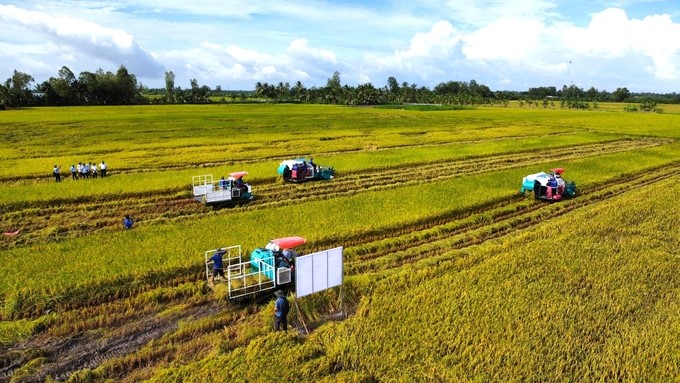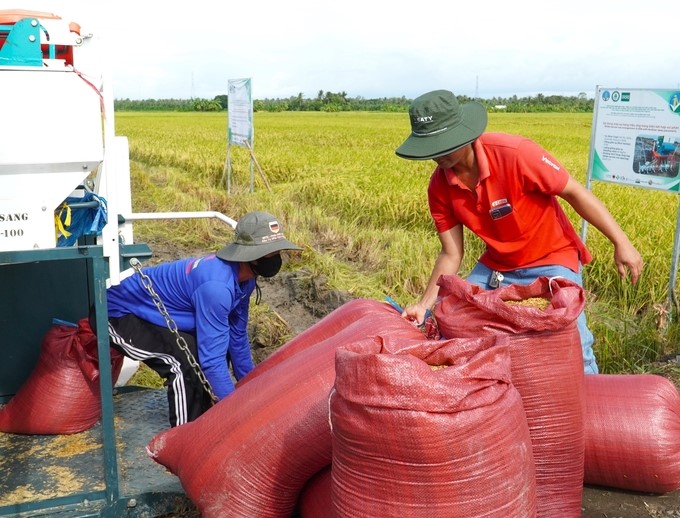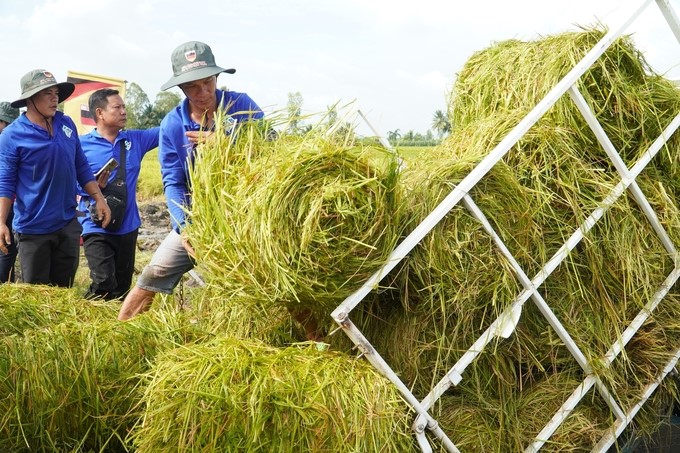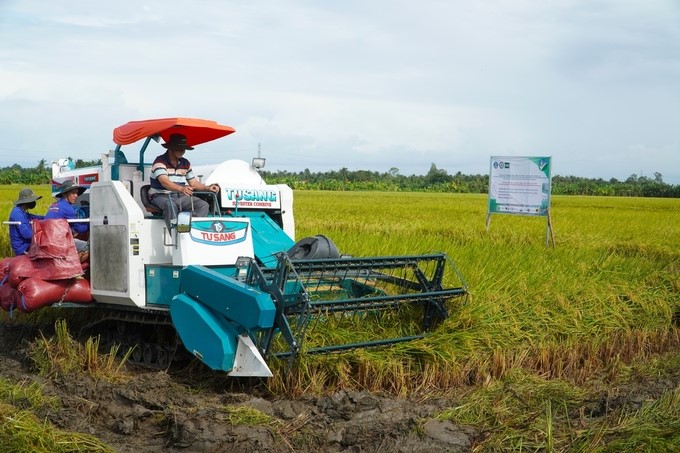May 23, 2025 | 13:44 GMT +7
May 23, 2025 | 13:44 GMT +7
Hotline: 0913.378.918
May 23, 2025 | 13:44 GMT +7
Hotline: 0913.378.918
On September 4, the Department of Crop Production (Ministry of Agriculture and Rural Development-MARD) coordinated with the Soc Trang Department of Agriculture and Rural Development to summarize seven pilot models of the Sustainable Development Project of 1 Million Hectares Specializing in High-Quality and Low-Emission Rice Cultivation Associated with Green Growth in the Mekong Delta until 2030 (referred to as the Project).
To implement the Project, the Department of Crop Production has built seven pilot models in five provinces: Kien Giang, Soc Trang, Tra Vinh, Dong Thap, and Can Tho city. These are localities representing three ecological sub-regions (upper, middle, lower) and different land areas (alum, salty alum, sweet alluvial, etc.) of the Mekong Delta.

The pilot model of the 1 million hectares of high-quality rice project in Soc Trang province is entering harvest. Photo: Kim Anh.
In the 2024 summer-autumn crop, three localities, including Can Tho city, Soc Trang, and Tra Vinh, have implemented four models with an area of 196 hectares.
Of these, two models at Tien Thuan Agricultural Cooperative (Can Tho city) and Phat Tai Agricultural Cooperative (Tra Vinh province) have completed harvesting with yields reaching 6.4 tons/ha and 6.1 tons/ha, respectively, which are 0.7 tons/ha and 0.2 tons/ha higher than non-model yield. The remaining two models at Hung Loi Agricultural Cooperative (Soc Trang province) and Phuoc Hao Agricultural Cooperative (Tra Vinh province) are harvesting.
The Department of Crop Production estimates that four pilot models' average yield in the 2024 summer-autumn crop will reach over 6.4 tons/ha, nearly 0.5 tons/ha higher than the average yield outside the model. Emission-reducing rice output will reach 1,262 tons.
In the 2024 autumn-winter crop, three models in Dong Thap province, Kien Giang province, and Can Tho city sowed 140 hectares. The average yield is estimated at more than 6.3 tons/ha, and output is 157 tons. It is expected that the models will harvest from mid-September to the end of October 2024.

All pilot models are purchased rice by affiliated businesses. Photo: Kim Anh.
Regarding profits, in Can Tho city, the total cost of rice production for the area in the model is 5% higher than that outside the model, but the profit in the model is 20% higher than outside the model.
In the remaining localities, the total rice production cost of the area in the model is 14–20% lower than the cost outside the model.
With the above results, Deputy Minister of Agriculture and Rural Development Tran Thanh Nam assessed that the models have created marks and major turning points in Mekong Delta farmers' thinking and action on production methods.
Most clearly, when visiting the models, Deputy Minister Tran Thanh Nam realized that farmers and cooperatives really wish to participate in the Project. Although some households in the cooperative initially did not want to participate due to a concern about the farming process requiring a decrease in seeds and fertilizers and a fear of unguaranteed productivity. However, when implementing the model and realizing its effectiveness, farmers returned to register and volunteered to participate in the model.

Deputy Minister of Agriculture and Rural Development Tran Thanh Nam assessed that pilot models have created marks and major turning points in Mekong Delta farmers' thinking and action on production methods. Photo: Kim Anh.
"This is a rare thing because many agricultural models often have to mobilize people to participate and rarely see farmers register. There may be problems in the implementation process, but it is not difficult to adjust as the models will continue to be piloted in the coming crops. People's agreement in thoughts and awareness is extremely important," Deputy Minister Nam emphasized.
Regarding the results of reducing greenhouse gas emissions, the model in Can Tho city is assessed to reduce the most. Specifically, the model reduces about 12 tons of CO2e/ha compared to farmers outside the model who continuously flood water and bury straw in the field; reduces 5 tons of CO2e/ha compared to farmers outside the model who apply alternate wet and dry (AWD) irrigation in the cooperative but bury straw in the field. At the same time, reduce about 2 tons of CO2e/ha compared to farmers outside the model of continuously flooding water but selling straw (collecting straw from the field).
In Soc Trang, the results show that the pilot model has emissions of 9.5 tons CO2e/ha/crop. Meanwhile, emissions outside the model are up to 13.5 tons of CO2e/ha/crop. Thus, the difference in gas emissions inside and outside the model is nearly 4 tons CO2e/ha/crop.

Promoting the removal of straw from fields is one of the effective measures to reduce greenhouse gas emissions. Photo: Kim Anh.
In Tra Vinh, on average, two pilot models applying emission-reducing rice production techniques have emissions of about 7.6 tons of CO2e/ha/crop, while outside the model is over 13 tons of CO2e/ha/crop. The difference in emissions is about 5.4 tons CO2e/ha/crop.
According to Deputy Minister Tran Thanh Nam, on average, pilot models reduce about 5 tons of CO2e. The MARD is currently negotiating with the World Bank (WB) and the Transformative Carbon Asset Facility (TCAF) to complete procedures related to the pilot payment of carbon credits. From there, build a payment mechanism and submit it to the Government for approval. It is expected that the summer-autumn crop of 2025 or the winter-spring crop of 2025-2026 can be piloted, with a source of about USD 20 million from the TCAF. Thereby, farmers participating in the Project may receive an additional amount of support.
Deputy Minister Nam especially emphasized and clarified that the highest goal of the 1 million hectares of high-quality rice project is to demonstrate the effectiveness of reducing production costs, reducing emissions, and increasing profits for farmers, not to sell carbon credits.
To continue implementing pilot models in the winter-spring crop of 2024-2025, Deputy Minister Nam requested units under the MARD and Mekong Delta localities to focus on nine issues. Of which, the focus is on the Department of Crop Production in coordination with specialized units and localities to advise on the seasonal calendar for the winter-spring crop of 2024-2025. Based on the pilot model area of 50 hectares, it can be expanded to adjacent cells and parcels.

Mekong Delta localities had plans to expand the 1 million hectares of high-quality rice project. Photo: Kim Anh.
Besides, the Department of Crop Production needs to coordinate with the Institute for Agricultural Environment (Vietnam Academy of Agricultural Sciences) to continue implementing emission reduction measurement (MRV) and appoint more professional staff to support the MRV measurement for point models. When the emission reduction coefficient results are available, they will be transferred to community agricultural extension forces at localities.
At the same time, the Department of Cooperatives and Rural Development, in coordination with the MARD's Institute for Public Policy and Rural Development, continues to advise and direct capacity building for agricultural cooperatives on the emission-reducing cultivation process.
The Institute of Water Resources Planning needs to soon complete sample designs and pilot models of irrigation to transfer to localities. By the dry season of 2025, localities participating in the Project need to upgrade irrigation systems (dredging canals, upgrading pumping stations) in pilot models.
Based on the results from the pilot models, Mekong Delta provinces participating in the 1 million hectares of high-quality rice project had plans to replicate. Localities that have not yet participated in the VnSAT Project, depending on conditions, can replicate the model to gain experience in implementation in the coming time.
Translated by Thu Huyen

(VAN) The People's Committee of Tra Vinh province has approved an adjustment to the investment policy for the Green Hydrogen Plant project, increasing its area to approximately 52.76 hectares.
![Reducing emissions from rice fields: [2] Farmers’ commitment to the soil](https://t.ex-cdn.com/nongnghiepmoitruong.vn/608w/files/news/2025/05/05/dsc08881jpg-nongnghiep-140632.jpg)
(VAN) Clean rice cultivation model in Thuong Tan commune, Bac Tan Uyen district, is assisting local residents in achieving sustainable agriculture by substantially reducing costs, increasing productivity, and protecting the environment.

(VAN) At the conference to disseminate Resolution No. 68, AgriS introduced its digital agricultural ecosystem and reaffirmed its commitment to accompanying the Government in promoting private sector development and sustainable agriculture.

(VAN) 'Blue Ocean - Blue Foods' initiative is designed to restore marine ecosystems and establish sustainable livelihoods for local communities by cultivating a minimum of 1,000 hectares of cottonii seaweed in the first three years.
/2025/05/21/4642-3-112707_603.jpg)
(VAN) The V-SCOPE project has made direct contributions to three out of six pillars of the Comprehensive Strategic Partnership between Vietnam and Australia.

(VAN) Facing the threat of rabies spreading to the community, Gia Lai province urgently carries out measures to vaccinate dogs and cats on a large scale.

(VAN) Disease-free livestock farming not only protects livestock herds but also stabilizes production and livelihoods for many farmers in Tuyen Quang.